Novel Orthogonal Momentum-Type Particle Swarm Optimization Applied to Solve Large Parameter Optimization Problems
Abstract
This study proposes an orthogonal momentum-type particle swarm optimization (PSO) that finds good solutions to global optimization problems using a delta momentum rule to update the flying velocity of particles and incorporating a fractional factorial design (FFD) via several factorial experiments to determine the best position of particles. The novel combination of the momentum-type PSO and FFD is termed as the momentum-type PSO with FFD herein. The momentum-type PSO modifies the velocity-updating equation of the original Kennedy and Eberhart PSO, and the FFD incorporates classical orthogonal arrays into a velocity-updating equation for analyzing the best factor associated with cognitive learning and social learning terms. Twelve widely used large parameter optimization problems were used to evaluate the performance of the proposed PSO with the original PSO, momentum-type PSO, and original PSO with FFD. Experimental results reveal that the proposed momentum-type PSO with an FFD algorithm efficiently solves large parameter optimization problems.
1. Introduction
Many well-known representative evolutionary computation (EC) techniques, such as genetic algorithms (GAs) [1–3], genetic programming (GP) [4], evolutionary programming (EP) [5, 6], evolutionary strategies (ESs) [7, 8], and particle swarm optimization (PSO) [9], have emerged as efficient computational tools for solving global optimization problems, especially for large parameter optimization problems (LPOPs). These EC techniques are sufficiently robust when coping with discontinuous, vast multimodal problems or with noisy search spaces since they do not depend on derivatives of objective functions and constraints. Among these techniques, PSO is easily implemented and computationally inexpensive as it has low memory and CPU costs. The PSO methodology involves creation of a population of particles such that each particle is capable of adjusting its flying velocity, according to its flying experience and the best experience of the group. Therefore, each particle in the PSO can be regarded as a cooperating agent.
The original PSO algorithm, developed by Kennedy and Eberhart in 1995 [9], was inspired by the swarm behaviors of flocks of birds and schools of fish. Thus, the PSO method is a swarm intelligence method [10] for solving global optimization problems, and it compares favorably to other evolutionary algorithms [11]. The original PSO is effective in determining optimal solutions in static environments, but performs poorly in locating a changing extremum. In addition, imposing a maximum value Vmax is necessary to limit the particle velocity. Shi and Eberhart introduced a parameter called inertia weight (w), which dampens particles’ velocities over time, allowing a swarm to converge efficiently and with increased accuracy [12, 13]. Furthermore, Clerc proposed using a constriction factor (K), which improves the ability of PSO to constrain and control velocities [14]. Eberhart and Shi found that K, combined with constraints on the maximum allowable velocity vector (Vmax), improved the PSO performance significantly [15]. Additionally, when utilizing PSO with a constriction factor setting, the Xmax for each dimension is the best approach. Constriction factor (K) implements velocity control for effectively erasing the tendency of some particles to spiral into ever-increasing velocity oscillations. Parsopoulos and Vrahatis presented an overview of recent approaches for solving global optimization problems using PSOs [16].
This work presents a novel orthogonal momentum-type PSO algorithm for locating the best position for each particle efficiently. The momentum-type PSO, proposed in previous work [17], has a delta momentum rule in the velocity-updating equation, and efficiently determines the physical motion of particles more reasonably than other PSO versions. The momentum-type PSO markedly outperformed the original PSO [9] and modified PSO [13] versions. Furthermore, this study incorporates the momentum-type PSO and well-known fractional factorial analysis, which utilize several factorial experiments, according to classical orthogonal tables, to identify intelligently the best combination of factors from two-level variables to enhance algorithmic search efficiency. The novel combination of the momentum-type PSO and fractional factorial design (FFD) is termed the momentum-type PSO with FFD herein. Ho et al. [18] and Lin [19] developed Taguchi orthogonal tables for their GA and PSO for constructing an orthogonal GA and orthogonal PSO. Their strategies markedly improved the search ability of their GA and PSO. In 1991, Bhote reported that classical fractional factorial analysis combined with evolutionary optimization is superior to the Taguchi method [20]. Consequently, this study proposes orthogonal PSO using the FFD, rather than Taguchi tables, for a velocity-updating equation of momentum-type PSO to analyze the best factor related to cognitive learning and social learning terms with the goal of enhancing algorithmic efficiency. This work also developed the original PSO with FFD, which combines the original Kennedy and Eberhart PSO and classical orthogonal arrays, to enhance the performance of the original PSO. Performance of the original PSO, momentum-type PSO, original PSO with FFD, and proposed momentum-type PSO with FFD were compared using 12 benchmark LPOPs.
2. Methodology of the Proposed Particle Swarm Optimization
2.1. Description of an Objective Function
The general form of an objective function with variable vector is expressed as . The variable represents the solution vector with N variables, and is defined as the set {xi, i = 1, N}. In PSO computation, each particle is assigned a fitness value based on the calculation of objective function. Moreover, the fitness value of a particle determines the best position of each particle over time and determines which particle has the best global value in the current swarm.
2.2. Momentum-Type Particle Swarm Optimization
2.3. Proposed Momentum-Type PSO with Fractional Factorial Design
2.4. Fractional Factorial Design (FFD)
To solve the operator shown in (10) and (11), the FFD used in this work is based on classical full factorial analysis with two-level, multivariable orthogonal tables [20]. Applying the fractional factorial analysis to the operator yields an arrangement of two-level factors that corresponds to the two possible states of the design variables. In the classical factorial experiments, the two levels of a design variable are labeled by “−” and “+”. Hence, and represent the two levels of the design variable Xi in this work. Table 1 lists the level distribution of seven factors with the same number of levels “−” and “+” at each column to retain the balance of a statistically designed experiment. The detailed steps of the numerical procedure for the fractional factorial analysis are as follows.
| Factor | A | B | AB | C | AC | BC | ABC | Output |
|---|---|---|---|---|---|---|---|---|
| Factor level | ||||||||
| Experiment 1 | − | − | + | − | + | + | − | f1 |
| 2 | + | − | − | − | − | + | + | f2 |
| 3 | − | + | − | − | + | − | + | f3 |
| 4 | + | + | + | − | − | − | − | f4 |
| 5 | − | − | + | + | − | − | + | f5 |
| 6 | + | − | − | + | + | − | − | f6 |
| 7 | − | + | − | + | − | + | − | f7 |
| 8 | + | + | + | + | + | + | + | f8 |
| Contribution | C1 | C2 | C3 | C4 | C5 | C6 | C7 | |
| Select level | + or − | + or − | + or − | + or − | + or − | + or − | + or − | |
| Best factor | or | or | or | or | or | or | or | |
(1) First, if N factors (termed by design variables in the PSO) each has two levels, build a table of m rows and m − 1 columns. The value m is defined by the integer . For example, if seven factors (N = 7) are associated with vector , then eight experiments (m = 8) are conducted for factorial analysis. As shown in Table 1, the levels “−” and “+” in columns A, B, and C are assigned to each cell position according to the classical full factorial principle [20]. In columns AB, AC, BC, and ABC, each level in the cells is determined from the inner products of columns A and B, columns A and C, columns B and C, and columns A, B, and C.
(2) The first experiment has a factor set to , obtained by combining the factors A to ABC with the assigned levels. In the following, its objective function, f1, is computed, and put it into the first position of column “Output”. Repeat the computations for the remaining seven experiments with function values f2, f3, …, and f8; then, the eight experiments for seven factors are finished.
(3) In column A, multiply the function values f1, f2, …, and f8 by the corresponding algebraic value −1 for level “−”, and 1 for level “+”, as listed in Table 1. The effect of factor A on the level is determined by adding the eight products together. The mathematical form for each factor i is . Here, Ui,j equals −1 when the cell level is at level “−”, and equals 1 when it is at level “+”. The summation C1 is placed in the first position in the row “Contribution” which is associated with factor A. Repeat the multiplication and summation operations for the remaining six values, C2, C3, …, and C7, and put them in corresponding positions in the row “Contribution”; the effects of factors B, C,…, and ABC on the levels are thus obtained.
(4) Check the signs of the seven values C1, C2, …, and C7 listed in the row “Contribution”; if the sign of Ci is negative, then place the symbol “−” in the row “Selected level” (Table 1). Otherwise, select symbol “+”. The dominant levels of the seven factors are thus determined.
3. Results and Discussion
3.1. Effect of Number of Particles
This function is a multimodal problem and has an analytical optimum of 1.216N. In this computation, dimensions were set at 10 and 100, and the maximum numbers of function evaluation for the two cases were set at 10000 and 100000, respectively. Moreover, the number of particles was 5, 10, 15, 20, 25, and 30 to investigate the effects of different swarm sizes of particles to orthogonal PSOs. Figures 1(a) and 1(b) reveal that the proposed momentum-type PSO with the FFD algorithm and few particles achieved a favorable convergence rate and numerical accuracy; nevertheless, many particles resulted in poor convergence. Using the proposed momentum-type PSO with FFD and few particles for N = 10 and N = 100 cases rapidly converges to optimal values 12.1598 and 121.598, respectively. In this study, numerical performance using Nparticle = 5 is better than other cases using large number sizes of particles. Similar results shown in Figures 2(a) and 2(b) are observed when using the original PSO with the FFD technique. Accordingly, this work set Nparticle = 5 for the momentum-type PSO with FFD and the original PSO with FFD algorithms in the following computations.
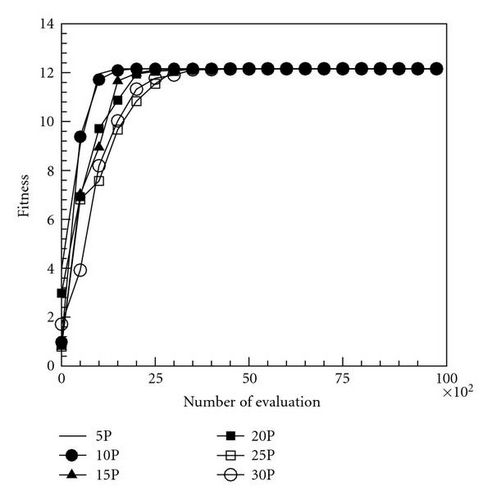
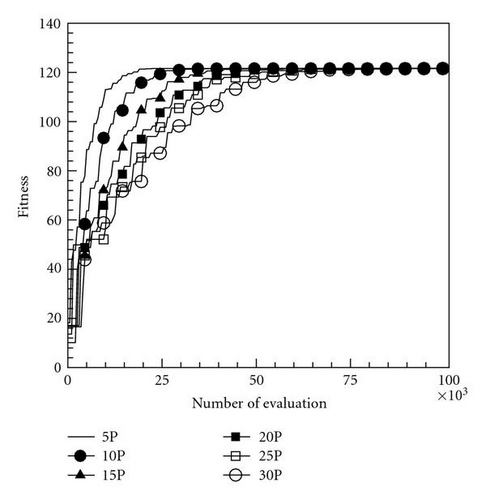
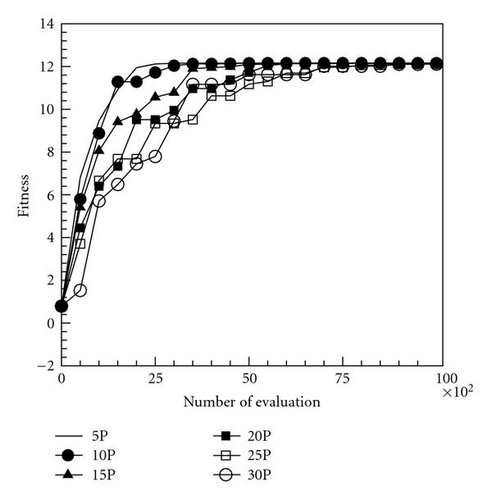
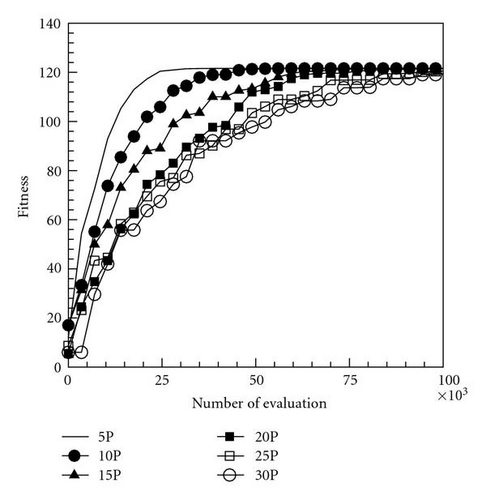
3.2. Experiments for 12 Large Parameter Optimization Problems (LPOPs)
Table 2 lists the 12 objective functions with range constraints and their global optima [18]. Notably, the objectives of problems 1–3 are set to maximize the objective functions f1–3, and other problems are set to minimize the objective functions f4–12. The optima of the first three maximal functions f1, f2, and f3 are 121.598, 200, and 185, respectively, and the minimal functions f4–12 are all zero. Table 3 lists the computational results for the 12 functions at a dimension of N = 100 using the four PSOs. Computational results reveal that the evaluation results for maximal functions f1, f2, and f3 using the proposed momentum-type PSO with FFD were 121.598, 174.452, and 182.798, respectively. These computational results are better than those computed by the other three PSOs. Additionally, the algorithmic performance of the PSOs with FFD is superior to that of PSOs without FFD. Consequently, the proposed PSO with FFD promoted solution searches more effectively than the PSO does without FFD. For the remaining nine minimal function evaluations, f4–12, the optima obtained using the proposed momentum-type PSO with FFD were 0.0, 11.946, 0.0, 0.00005, 0.000039, 3781.879, 92.874, 88.0, and 0.000059, respectively, and the average solutions were 0.0, 32.4641, 0.0, 0.0001, 0.0139, 5676.0005, 181.8753, 88.2285, and 0.1009, respectively. Both the best and average results are the best when compared with solutions obtained by the other three PSOs. Additionally, all MAEs and standard deviations are lowest for the nine optimization functions evaluated by the proposed momentum-type PSO with FFD over 20 independent runs. From the computational results (Table 3), the proposed momentum-type PSO with FFD performed well in solving LPOPs. Figures 3(a)–3(l) represent the convergence histories of the 12 objection functions obtained by the four PSOs. The proposed momentum-type PSO is superior to the other PSOs in terms of convergence rate and optimal solution (Figures 3(a)–3(c)). Although the convergence rate of the original PSO is relatively poor for solving LPOPs, it can be significantly improved by introducing FFD into the PSO algorithm. Figures 3(d)–3(l) present results similar to the maximization cases.
| Problems | Objective functions and ranges | Optima |
|---|---|---|
| 1 | 1.21598N | |
| 2 | ≈ 2N | |
| 3 | 1.85N | |
| 4 | 0 | |
| 5 | 0 | |
| 6 | 0 | |
| 7 | 0 | |
| 8 | 0 | |
| 9 | 0 | |
| 10 | 0 | |
| 11 | 0 | |
| 12 | 0 | |
| f(x) | Algorithms | fopt | fbest | favg | |fopt − favg| | MAE | SD (20 runs) |
|---|---|---|---|---|---|---|---|
| f1 | Original PSO | 121.598 | 26.5864 | 15.3709 | 106.2271 | 1.0623 | 5.8322 |
| Momentum-type PSO | 121.5966 | 119.6452 | 1.9528 | 0.0195 | 3.2968 | ||
| Original PSO with FFD | 121.5730 | 120.6245 | 0.9735 | 0.0097 | 2.7499 | ||
| Momentum-type PSO with FFD | 121.5980 | 120.3738 | 1.2242 | 0.0122 | 2.2866 | ||
| f2 | Original PSO | 200 | 41.3325 | 35.9429 | 164.0571 | 1.6406 | 2.9219 |
| Momentum-type PSO | 147.5408 | 135.8634 | 64.1366 | 0.6414 | 8.0647 | ||
| Original PSO with FFD | 163.7965 | 150.1892 | 49.8108 | 0.4981 | 6.3295 | ||
| Momentum-type PSO with FFD | 174.4516 | 166.6228 | 33.3772 | 0.3338 | 6.0346 | ||
| f3 | Original PSO | 185 | 41.7656 | 36.0755 | 148.9245 | 1.4892 | 5.6901 |
| Momentum-type PSO | 128.7731 | 116.8754 | 68.1246 | 0.6812 | 11.8977 | ||
| Original PSO with FFD | 165.4799 | 140.0511 | 44.9489 | 0.4495 | 25.4287 | ||
| Momentum-type PSO with FFD | 182.7978 | 174.9624 | 10.0376 | 0.1004 | 7.8354 | ||
| f4 | Original PSO | 0 | 1.3102 | 462.9955 | 462.9955 | 4.6300 | 461.6853 |
| Momentum-type PSO | 0.0001 | 1.9415 | 1.9415 | 0.0194 | 1.9413 | ||
| Original PSO with FFD | 3.6828 | 9.2072 | 9.2072 | 0.0921 | 5.5244 | ||
| Momentum-type PSO with FFD | 0.0000 | 0.0000 | 0.0000 | 0.0000 | 0.0000 | ||
| f5 | Original PSO | 0 | 1685.8392 | 1774.6315 | 1774.6315 | 17.7463 | 88.7923 |
| Momentum-type PSO | 408.6802 | 565.3514 | 565.3514 | 56.5351 | 156.6713 | ||
| Original PSO with FFD | 35.6695 | 76.3567 | 76.3567 | 0.7636 | 40.6872 | ||
| Momentum-type PSO with FFD | 11.9463 | 32.4641 | 32.4641 | 0.3246 | 20.5178 | ||
| f6 | Original PSO | 0 | 52.4517 | 186.2910 | 186.2910 | 1.8629 | 133.8393 |
| Momentum-type PSO | 0.0000 | 1.3711 | 1.3711 | 0.0137 | 1.3711 | ||
| Original PSO with FFD | 0.0000 | 0.0000 | 0.0000 | 0.0000 | 0.0000 | ||
| Momentum-type PSO with FFD | 0.0000 | 0.0000 | 0.0000 | 0.0000 | 0.0000 | ||
| f7 | Original PSO | 0 | 0.0001 | 0.0001 | 0.0001 | 0.0000 | 0.0000 |
| Momentum-type PSO | 0.0001 | 0.0211 | 0.0211 | 0.0002 | 0.0210 | ||
| Original PSO with FFD | 0.0001 | 0.0001 | 0.0001 | 0.0000 | 0.0000 | ||
| Momentum-type PSO with FFD | 0.0001 | 0.0001 | 0.0001 | 0.0000 | 0.0000 | ||
| f8 | Original PSO | 0 | 0.4069 | 3.9570 | 3.9570 | 0.0396 | 3.5501 |
| Momentum-type PSO | 0.0520 | 1.3377 | 1.3377 | 0.0134 | 1.2857 | ||
| Original PSO with FFD | 0.0000 | 0.6476 | 0.6476 | 0.0065 | 0.6476 | ||
| Momentum-type PSO with FFD | 0.0000 | 0.0139 | 0.0139 | 0.0001 | 0.0139 | ||
| f9 | Original PSO | 0 | 28122.4766 | 29843.7729 | 29843.7729 | 298.4377 | 1721.2964 |
| Momentum-type PSO | 7731.2314 | 9897.2021 | 9897.2021 | 98.9720 | 2165.9706 | ||
| Original PSO with FFD | 5363.7783 | 6583.7198 | 6583.7198 | 65.8372 | 1219.9415 | ||
| Momentum-type PSO with FFD | 3781.8799 | 5676.0005 | 5676.0005 | 56.7600 | 1894.1206 | ||
| f10 | Original PSO | 0 | 577.8867 | 64444.4250 | 64444.4250 | 644.4443 | 63866.5383 |
| Momentum-type PSO | 373.7911 | 635.0241 | 635.0241 | 6.3502 | 261.2330 | ||
| Original PSO with FFD | 341.0312 | 1292.7659 | 1292.7659 | 12.9277 | 951.7347 | ||
| Momentum-type PSO with FFD | 92.8743 | 181.8753 | 181.8753 | 1.8188 | 89.0009 | ||
| f11 | Original PSO | 0 | 231.3600 | 319.4241 | 319.4241 | 3.1942 | 88.0640 |
| Momentum-type PSO | 88.0000 | 89.7067 | 89.7067 | 0.8971 | 1.7067 | ||
| Original PSO with FFD | 88.0000 | 89.3653 | 89.3653 | 0.8937 | 1.3653 | ||
| Momentum-type PSO with FFD | 88.0000 | 88.2285 | 88.2285 | 0.8823 | 0.2285 | ||
| f12 | Original PSO | 0 | 0.2118 | 171.7896 | 171.7896 | 1.7179 | 171.5778 |
| Momentum-type PSO | 0.0183 | 3.2176 | 3.2176 | 0.0322 | 3.1992 | ||
| Original PSO with FFD | 0.8876 | 7.6815 | 7.6815 | 0.0768 | 6.7939 | ||
| Momentum-type PSO with FFD | 0.0001 | 0.1009 | 0.1009 | 0.0010 | 0.1008 | ||
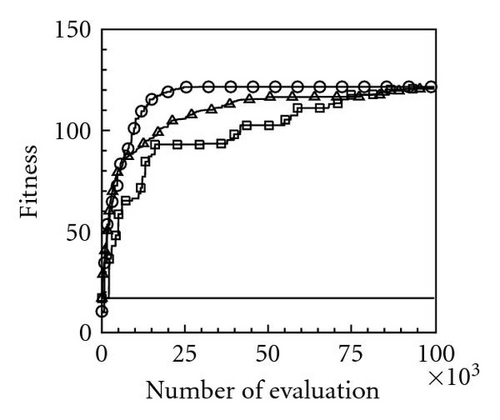
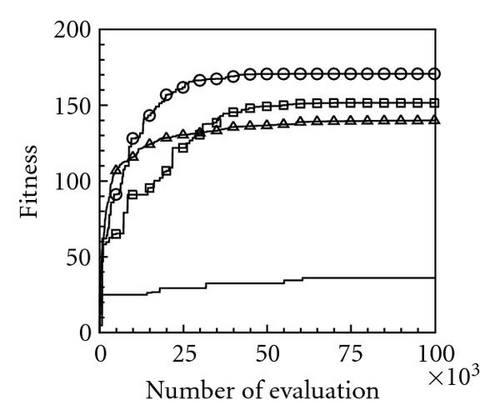
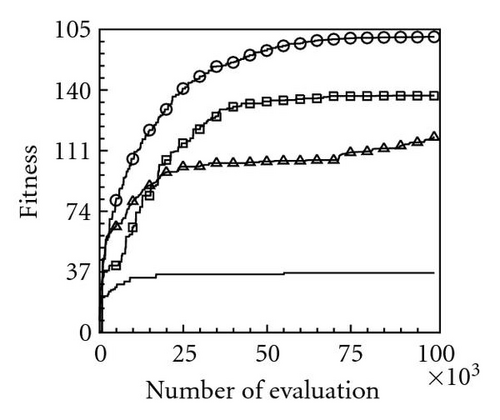
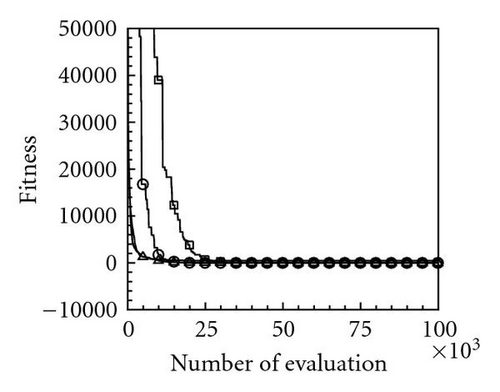
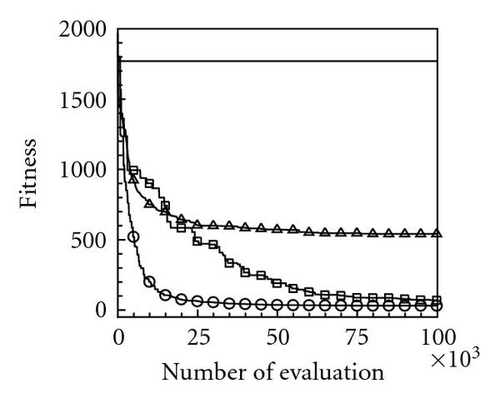
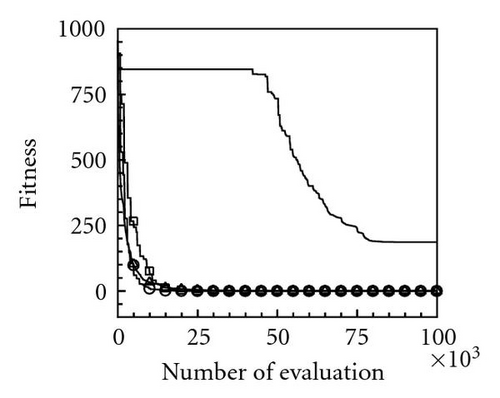
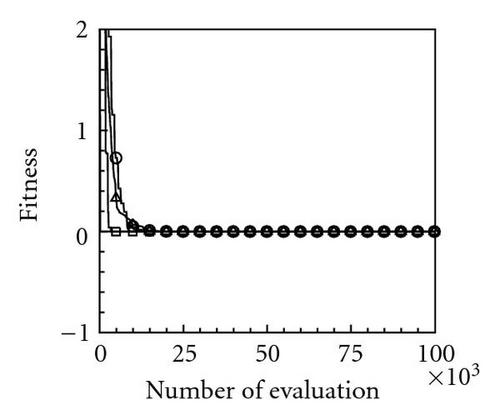
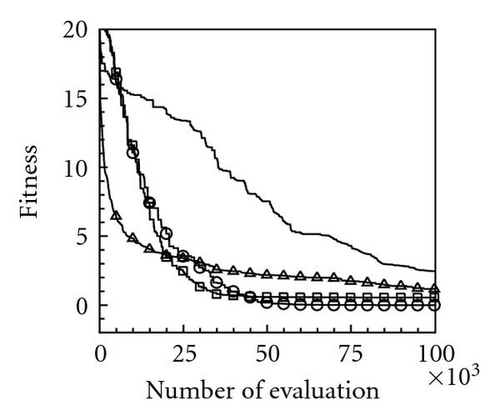
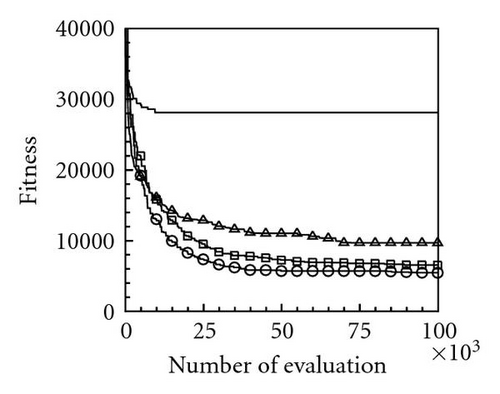
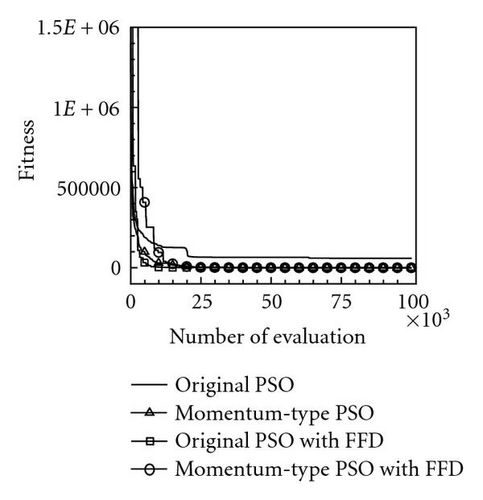
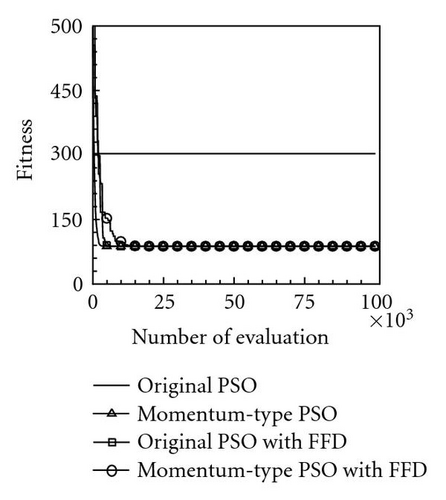
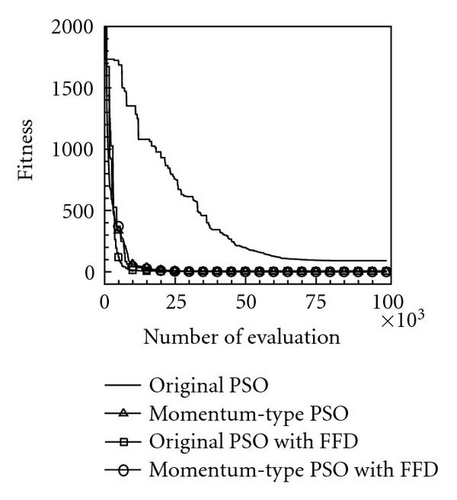
4. Conclusion
This study examined the performance of the proposed momentum-type PSO with the FFD algorithm, which uses the delta momentum rule to update particle velocity and FFD to locate a particle’s best location for handling LPOPs. Using the momentum-type PSO, each particle can adjust its velocity vector according to its previous velocity change rate. The new location of a particle is then determined by analyzing the best combination of cognitive and social learning terms via several factorial experiments based on the FFD. Moreover, this work modified the original PSO by incorporating with FFD, which also employs the classical orthogonal tables, and improved significantly the efficiency of the original Kennedy and Eberhart PSO. Through 12 benchmark function assessments, the proposed momentum-type PSO algorithm outperformed the original PSO, momentum-type PSO and original PSO with FFD in terms of solution accuracy, numerical error and standard deviation. This work also determined that algorithmic performance of the proposed PSO with FFD is superior to that without FFD. Numerical results show that the proposed momentum-type PSO with FFD algorithm is efficient and is a promising method for solving LPOPs.




